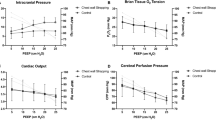Summary
A porcine model for an acute lethal arterial subdural bleeding in man is presented. Blood from the abdominal aorta was led via an electronic drop recorder into a collapsed intracranial subdural rubber balloon. Systemic arterial pressure (SAP), two intracranial pressures and 6 other vital parameters were monitored continuously in spontaneously breathing (n=4) and mechanically ventilated (n=4) pigs.
In both animal groups bleeding caused an immediate rise in intracranial pressures (ICP) with transtentorial pressure gradients developing. As a result the cerebral perfusion pressures (CPP) decreased progressively, leading to an isoelectric EEG.
In spontaneously breathing animals, the pressure changes resulted in apnoea within 2–4 minutes, irregularities in heart rhythm and in a marked rise in SAP (the Cushing reaction). A final collapse of all pressures occurred after 222 ± 68 sec at a mean bleeding volume of 10.3 ± 1.9ml.
In contrast, in mechanically ventilated animals, the course of bleeding was less dramatic. No change in cardiac rhythm or rise in SAP appeared despite a larger mean bleeding volume (12.0 ± 1.6ml). Instead, SAP slowly fell, reaching a level of approximately 40 mm Hg within 1 hour, while CPP concomitantly decreased from 120 mm Hg to 15 mm Hg.
The findings in this and in a parallel study are explained in terms of the intracranial volume tolerance concept (Zwetnowet al. 1986). The beneficial effect of assisted ventilation on the course of subdural bleeding is multifactorial, involving both metabolic and mechanical mechanisms.
Similar content being viewed by others
References
Ganz JC, Zwetnow NN (1992) Hypoxia and asphyxia in the brain stem — a determinant of the Cushing response. In manuscript
Habash AH, Zwetnow NN, Ericson K, Lofgren J (1983) Arteriovenous epidural shunting in epidural bleeding. Radiological and physiological characteristics. An experimental study in dogs. Acta Neurochir (Wien) 67: 219–313
Häggendal E, Lofgren J, Nilsson NJ, Zwetnow NN (1970) Effects of varied cerebrospinal fluid pressure on cerebral blood flow in dogs. Acta Physiol Scand 79: 272–279
Lofgren J, Zwetnow NN (1972) Kinetics of arterial and venous hemorrhage in the scull cavity. In: Brock M, Dietz H (eds) Intracranial pressure I. Springer, Berlin Heidelberg New York, pp 155–159
Lofgren J, Zwetnow NN (1973) Influence of a supratentorial expanding mass on intracranial pressure-volume relationship. Acta Neurol Scand 49: 599–612
Orlin JR, Osen KK, Hovig T (1991) Subdural compartment in pig: a morphological study with blood and HRP as subdural tracers. Anat Rec 230: 22–37
Orlin JR, Zwetnow NN, Bjorneboe A (1992) Changes in CSF-pressures during experimental acute arterial subdural bleeding in pig. Acta Neurochir (Wien) 118: 146–158
Schrader H, Hall C, Zwetnow NN (1985) Effect of prolonged supratentorial mass expansion on regional blood flow and cardiovascular parameters during the Cushing response. Acta Neurol Scand 72: 283–294
Schrader H, Lofgren J, Zwetnow NN (1985) Influence of blood pressure on tolerance to an intracranial expanding mass. Acta Neurol Scand 71: 114–126
Shalit MN, Cotev S (1974) Interrelationship between blood pressure and regional cerebral blood flow in experimental intra-cranial hypertension. J Neurosurg 40: 594–602
Siesjo BK, Zwetnow NN (1970) Effects of increased cerebrospinal fluid pressure upon adenine nucleotides and upon lactate and pyruvate in rat brain tissue. Acta Neurol Scand 46: 187–202
Steiner L, Bergvall U. Zwetnow NN (1975) Quantitative estimation of intracerebral and intraventricular hematoma by computer tomography. Acta Radiol [Suppl] 346: 143–154
Steiner L, Lofgren J, Zwetnow NN (1973) Cerebral blood flow in experimental intracranial bleed. Acta Neurochir (Wien) 29: 257–274
Steiner L, Lofgren J, Zwetnow NN (1975) Characteristics and limits of tolerance in repeated subarachnoid hemorrhage in dogs. Acta Neurol Scand 52: 241–267
Steiner L, Lofgren J, Zwetnow NN (1975) Lethal mechanism in repeated subarachnoid hemorrhage in dogs. Acta Neurol Scand 52: 268–293
Zwetnow NN (1970) Effects of increased cerebrospinal pressure on the blood flow and on the energy metabolism of the brain. Acta Physiol Scand [Suppl] 339: 1–31
Zwetnow NN (1975) Interrelations between ICP and blood circulation within the intracranial space. In: Lundberg N, Pontèn U, Brock M (eds) Intracranial pressure II. Springer, Berlin Heidelberg New York, pp 249–253
Zwetnow NN, Habash AH, Lofgren J, Håkanson S (1983) Comparative analysis of experimental epidural and subarachnoid bleedings in dogs. Acta Neurochir (Wien) 67: 67–101
Zwetnow NN, Schrader H, Lofgren J (1986) Effects of continuously expanding intracranial lesions on vital physiological parameters. An experimental study. Acta Neurochir (Wien) 80: 47–56
Author information
Authors and Affiliations
Additional information
This study has been supported by the University of Oslo, The Anders Jahre Foundation for The Advancement of Science, and by the Norwegian Cancer Society.
Rights and permissions
About this article
Cite this article
Zwetnow, N.N., Orlin, J.R., Wu, W.H. et al. Studies on supratentorial subdural bleeding using a porcine model. Acta neurochir 121, 58–67 (1993). https://doi.org/10.1007/BF01405184
Issue Date:
DOI: https://doi.org/10.1007/BF01405184




